When Kathryn Clayton tends to the personal poisonous herb garden she keeps at her home in Cambria, she thinks not of the harm they can do, but of all of the good.
These taboo herbs—hemlock, nightshade, and mandrake among them—were at one time the only medicines known to man; the only means to soothe, heal, or sedate. Of course, when consumed under unsavory circumstances, these sprouts can conjure a darker result.

- PHOTO BY JAYSON MELLOM
- EVERY GARDEN IS MAGIC: Exotic herbs are collected and catalogued at Spellbound in Cambria—herbs with the power to transform and delight, if you only know who to ask.
“There is a great power behind these plants, and I have a great reverence for them,” Clayton says during an interview at her Cambria herb shop and nursery, Spellbound. “They could do something to a man that it would take a bullet to do. One little bite of this innocuous herb—a single crushed caster bean, for instance, and you will get sick or die. There is no question.”
On the flip side, Mother Nature is known to bring miraculous benefits to the sick and ailing. Want proof? As Clayton likes to quip, “Just ask your grandma’s grandmas’ grandma.” They knew which herbs to ingest whole, which herbs to smash into paste, and which herbs to take sparingly, diluted within a high dose of alcohol or vinegar.
Clayton has not forgotten what our ancestors once knew.
On any given day, Clayton will walk among her rows of glistening jars and recommend an herb for what ails you—perhaps earthy, orange turmeric powder for inflammation or rosemary tea for improved memory. She also prescribes plants for pure delight—something stressed-out Americans are in sore need of.
It’s no wonder that the Western herbalist consumes a revolving mix of plants each day: by tea, tincture, or sprinkled on her food. Like most self-proclaimed “herbies,” she also consumes a lot of thick-bound books.
In them, you might find a passage about “bloodroot,” a red flowering plant used by eastern Native American tribes to treat ulcers and skin conditions, or Middle Eastern “myrrh,” a sap-like substance applied to the mouth for soreness and toothaches.
Depending on how you look at it, you could also call these spell books.
“I love working in the garden, communing with nature,” Clayton says. “You don’t just take that pretty bundle and put it into a vase and admire it. You put these plants into your food, into your body. There is no more transformative substance on earth.”
The witch has landed
Clayton believes this ritual constitutes true magic.
This time of year, Clayton’s shop—a historic Cambria home built in 1876—feels doubly mystical. It’s not just the Halloween decorations, which are plentiful. The sloped wooden floors creaked at every turn, as if trying to convey some sort of ancient wisdom. The trees outside, once full and green, have begun to look gnarled and naked against the soft, ethereal coastal light.
No surprise here: Clayton is a big fan of Halloween—that is, to say, the real Halloween (the holiday probably originated with the ancient Celtic festival of Samhain, when people lit bonfires and wore costumes to ward off roaming ghosts).
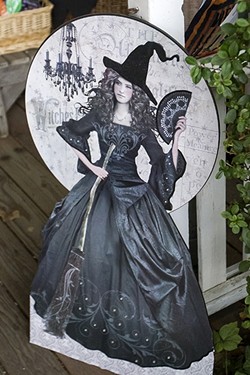
- PHOTO BY JAYSON MELLOM
- LIFTING THE VEIL: Before Cambria became overrun with scarecrows each fall, one raven-cloaked “herbie” brought Halloween out of the shadows once and for all.
Clayton is not a pagan, Wiccan, or a witch. She doesn’t whip off her clothes and dance in the forest under a full moon, although she doesn’t judge those who might. Instead, on Halloween Clayton brews herbal tea and performs small personal rituals. These are gestures as minuscule and potent as mustard seeds, but they mean something to her.
“I light a few candles and like to thank my ancestors for what I’ve got,” she says simply, and her tone is one of genuine gratitude for a life well lived.
What she’s got is rich, indeed: a successful business and a quiet home, where she lives happily with her cat, Weasley.
Maybe it’s the “thinning of the veil” as Samhain approaches, or maybe it’s the giant “plague doctor” scarecrow that greets customers out front (the creature is arresting, with a long, pointed beak and two gigantic black wings consisting of 106 black feathers). There is a self-possessed power about Clayton. The former raven-haired Rams cheerleader (yes, she was a dancer in a past life) is cloaked in inky fabric, but her clear eyes sparkle.
I ask if she thinks she would be called a witch if she had lived a few hundred years ago. The shopkeeper flashes a mischievous grin that tells me all I need to know.
She laughs, adding that she’s had some “trouble” with the shop’s previous owner, a fellow herb-peddler.
As it turns out, even the faintest whiff of perceived witchery—or a powerful woman left to her own devices—can still feel threatening to the general population.
Readers may remember the shop’s more cuddly name, “Hearts Ease,” and light blue paint job. The main draw? A make-your-own potpourri station. Witchy it was not.
Cambria calling
In 2004, Clayton was living in Southern California, where she had retired from the entertainment business (her credits include the 1986 war flick, Platoon). After her daughter left home, she felt a void.
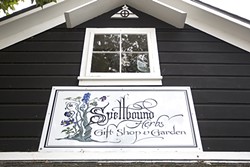
- PHOTO BY JAYSON MELLOM
Instinctually, Clayton turned to her love of the natural world, which began with the first herb garden she planted at age 12. That was back in 1966, when moms were more likely to wield a can opener than a shovel.
“I’ve been an herbalist all my life, by nature and by study,” Clayton says.
Back to 2004: Clayton had heard about Heart’s Ease through her connection to the herbie counterculture, which is still very much alive today (as Clayton likes to say, “herbies talk.”)
“It’s an underground community. When you go back east, you get on the horn and say, ‘I’m gonna be in Duluth, don’t miss this farm, don’t miss this shop,” Clayton says. “So, I came up here and fell in love with the shop and the area. I loved coming into Cambria and seeing the pines. I could breathe.”
Call it serendipity or coincidence, but both the herb shop and the building were up for sale. She purchased Heart’s Ease in 2005.
“When a jar went down, I would replace the potpourri with a unique herb like cramp-bark,” Clayton recalls.
Another change: Clayton’s vibrant Halloween decorations. This was way before Cambria’s annual Scarecrow Contest, which now speckles the seaside town with unique frights crafted by locals.
“When I began fall decorating, nobody did Halloween; no one did harvest or even scarecrows. Not with a 10-foot pole,” Clayton says. “The first year, I went full blast Halloween. Some people in town were not too happy with me. They’d say, ‘You’re anti-Christian.’ I’m not anti-anything. I’m an herbie. They thought the witch had landed.”
About three years ago, Clayton stepped even farther into her own vision, renaming the shop “Spellbound” and painting the whole thing black.
Local backlash was swift, but as Clayton says: “People who know me know that I have a black shop, not a black heart.”
Herbs for delight
To find this “witch’s” heart, you must look toward the ground, to the very earth beneath your feet. On this brisk, cloudy day, Clayton took me for a tour through her garden, nestled just behind the shop.
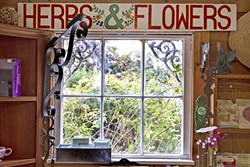
- PHOTO BY JAYSON MELLOM
Each spring, the shop holds a Faerie Festival that brings bunches of giddy kids to the green space. Here, she’s got a Hobbit house, complete with rounded front door. Playing cards—strung near Alice’s tea table—are hung from twisted branches, swaying in the salty breeze. Clayton pointed out the elderberry tree that stands above a miniature faerie landscape cut into the side of native rock.
“This tree has been here long before me or the shop,” she says, adding that, according to pagan folklore, elder is known to provide protection from negative spirits.
You can call this superstition or New Age bunk. But—and here’s the fun question: Doesn’t understanding the colorful narratives of the natural world make the universe just a tad bit more interesting—a bit more alive with wonder?
“I think you can look at it as everything is a miracle or nothing is,” Clayton says. “I think there is magic in every garden and every garden is magic.”
Women, in league with nature
The resistance to—and fear of—the power of nature is not new. Looking back in time, it’s not hard to understand why the wielders of these first powerful gardens came to be ostracized as devilish fiends. Imagine the horror an average wound would produce in colonial New England. Thousands died from their injuries. Many were “miraculously” cured by “potions and spells.” Read: medicinal plants.
“These witches—these first wise women, if you will—were the knowledgeable ones. They were the people you went to when you had a scrape or a broken leg. Can you imagine, with sepsis and infection? For the pain alone, you needed something,” Clayton says. “Hemlock, mandrake, and all those old herbs that are actually poisons, were used for anesthesia and pain. At the same time, these wise women say, ‘Here’s your herb, now say this incantation three times, then burry it.’”
Clayton admits that many of the rituals (rubbing yourself with a live chicken, say) were “more than a bit backwards,” but that’s not the point. These ancient herbs did their magic, and they still do today. The women behind the mortar and pestle? In a way, they’re still getting burned, marginalized.
“Wise women are still revered, but also feared, for their power,” Clayton says.
Dark times, green measures
We all know what happened to those first women in power, but Clayton has no interest in salacious witch-hunts. The history buff’s got her head stuck in the Middle Ages.

- PHOTO BY JAYSON MELLOM
- WITCHY WOMAN: Power, spirituality, feminism—life and death: all of these grand dealings can be coaxed out of the many herbs catalogued at Kathryn Clayton’s Cambria shop, Spellbound.
Imagine you’re in England during the summer of 1348, and everyone you know is getting sick. The bodies are piled in the streets—too many to count. Whole families are obliterated. Men are whipping themselves in an effort to find salvation; women turned to bloodletting—leeches—to rid themselves of the disease.
Out of this chaos emerges an almost demonic looking being, yet his intention is pure and powerful. It is the plague doctor, with his dark robe and long, crow-like snout—a crude gas mask. This is the meaning of the scarecrow that stands in front of Clayton’s shop. It is a misunderstood beacon of hope.
“These men held powerful herbs in their mask—which were secured with glass eyes and a beak,” Clayton says. “They’d bless people; hold out a stick to poke the bodies to see if anyone was still alive and could be saved.”
Back in those days, doctors used rosemary, basil, horehound, laurel, mint, marigold, and angelica, a tall green plant whose stalks were cooked like celery.
“Rosemary is a common herb, it grows well, and you can put it in a roast, but scientists are doing studies for Alzheimer’s now showing the herb is amazingly potent,” Clayton says. “If you look back in time, Shakespeare wrote, ‘There’s rosemary, that’s for remembrance.’ He knew back then the powers that it held.”
Clayton will tell you it was this kind of knowledge that traveled by boat to the New World—the product of which ended up in bubbling cauldrons heated over crude wooden stoves.
“These women were kind, gracious healers who respected the earth and each other,” Clayton says. “There is a resurgence of women that still carry on this knowledge today, yet many are still in the shadows.”
The village herbalist
Kirstin Sherritt alchemizes herbal remedies at her open-air tea and herb shop tucked away near San Luis Obispo creek. Although just steps away from downtown San Luis Obispo, her lush alcove, filled with glass jars and sunlight, feels like another world.
Sherritt is blonde, blue-eyed, and breezy, the Betty to Clayton’s Veronica. Still, both women claim the same obsession.
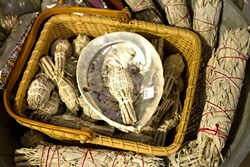
- PHOTO BY JAYSON MELLOM
Although Sherritt’s been working with herbs for 20 years, don’t call her a “healer” or “practitioner.”
“I like ‘village herbalist.’ I assist people; I give them tools to help in their journeys,” Sherritt says. “I say, ‘You’re the healer. You came here. You came and sought out the tools. I am simply a resource.’”
Still, what the herbalist does is some kind of magic. One frazzled woman might be battling undue stress; a young man may struggle with opium withdrawal. Yet another may be dealing with the aftermath of traumatic brain injury.
Sherritt listens. She nods. Then, she gets to mixing up a pinch of blood-cleansing dandelion or cognition-strengthening ashwagandha. She says she’s seen a sharp uptick in herbal interest since opening shop a dozen years ago.
“Even just five years ago, turmeric was a super exotic herb; now, mainstream people are coming in and asking for it,” Sherritt says. “These herbal remedies are woven deeply into our human DNA. We cast off the natural world in so many ways. Now, people are trying to get back what we’ve forgotten.”
Remembering our roots
Take classic cocktail culture, for instance. Strip away the trendy name of the drink, and what do you taste? “Bitters,” which are in fact tinctures featuring aromatic herbs, bark, or roots infused in alcohol. These, too, were once used as natural medicines.
“Why do you think people began drinking bitters in the first place?” Sherritt asks, between sips of tea. “You’d have a big meal, then enjoy a cocktail with bitters afterward, which aided in digestion. Suddenly, you’d feel more energetic, more sexy. Maybe you go dancing with your partner. Suddenly you’re connecting with life, enjoying life.”
Like so many self-taught herbalists, Sherritt learned the bulk of her knowledge from a mélange of books, personal experience, and gracious guides. Arroyo Grande herbalist and organic farmer Ruth Maddocks continues to be an influential mentor (you can find Maddocks’ salves, roll-ons, and flower essences at The Secret Garden). The hormonal regulation tincture is extremely popular.
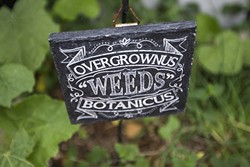
- PHOTO BY JAYSON MELLOM
“I have women coming in to buy three bottles at a time. Menopausal women are seeing relief from night sweats, hot flashes, headaches, and irritability,” she says. “Talk about a serious transformation.”
The powerful elixir is full of natural wonders, some of which you might want to Google: wild yam, sarsaparilla, chaste berry, black cohosh. Yes, messing with your own chemistry is serious business—perhaps one of the biggest magic tricks plants can perform (some might argue you are your hormones).
Sherritt reminds her clients to do their own research.
“Herbal healing is one of our last, true bonafide freedoms,” she says. “In the past 100 years, there have been amazing feats in medical history. However, there have also been some not-so-good things, like the fact that people have given away the vital power of their participation in their own healing.”
Understanding the herbal world is like diving into a new genre of music or the night sky. Like the universe, it’s always expanding.
“We rely on each other,” Sherritt says. “It still gives me chills when I remember when a Native American healer gave me a piece of a root that he works with. In his culture, you only work with eight or so plants, and your relationship deepens with them over a lifetime,” Sherritt says. “It was a tremendous gift—a vast wealth of information. That’s where the translation and passing on of this knowledge becomes so valuable.”
Into the wild
You can join a reputable organization like the American Herbalists Guild or take an online course, but—and Sherritt is wise to underscore this fact—there is no nationally recognized academic degree in “herbal studies.”
- DOUBLE, DOUBLE, TOIL AND BUBBLE: Want to learn how to harness the power of herbal magic in your life? Stop by Spellbound, at 4101 Burton Drive in Cambria, or pay a visit to The Secret Garden, located at 740 Higuera St. in SLO. For information on Ruth Maddocks’ organic farm in Arroyo Grande, go to ruthsherbalremedies.com.
Maybe that’s a shame. Or, maybe that’s natural. The more you try to grasp at the powers of herbal healing, the more it recedes into the mist. Knowledge is amassed through centuries of shared experience and experimentation. No one textbook can claim to explain the great mystery that links us to our natural surroundings.
“In this modern world, we are scrambling for security, to feel safe and in control, but the mystery of life holds the truth. It holds everything,” Sherritt says. “Going deep into the mystery; this is how you find your truth and your way.”
For Clayton in Cambria, no words could be truer. She is at peace kneeling in her garden, surrounded by leaves, berries, and flowers that hold the vast riddle of life and death.
Here, from this earthen vantage point, she sees the invisible seeds of knowledge that will continue thriving long after she’s gone. Cutting a piece of milkweed from her garden, she recognizes that it “bleeds” a creamy lifeblood.
“When I do this, I thank the plant, every single time,” Clayton says. “I say, ‘I appreciate what you’re giving me. Thank you for all that you have done.’”
Hayley Thomas Cain believes all gardens are magic. She can be reached at [email protected].
Comments